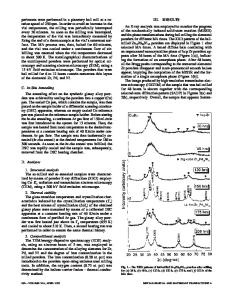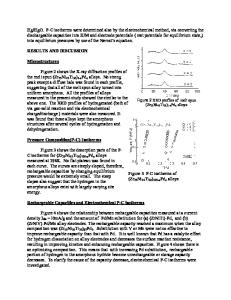Oxidation of amorphous Zr 70 Pd 30 and coarse crystalline Zr 2 Pd
- PDF / 965,292 Bytes
- 6 Pages / 612 x 792 pts (letter) Page_size
- 79 Downloads / 299 Views
MM10.6.1
Oxidation of amorphous Zr70Pd30 and coarse crystalline Zr2Pd Lioba Jastrow, Uwe Köster Dept. of Biochemical and Chemical Engineering, University of Dortmund D-44221 Dortmund, Germany
Abstract: Zr-based bulk metallic glasses are of increasing interest due to their excellent properties, e.g. high elastic limit or catalytic activity. For some applications (golf clubs, hydrogen storage) a good oxidation resistance is necessary; in other cases (catalysis) fast oxidation is required. Zr-Pd melt-spun glasses are known to exhibit "catastrophic" oxidation even at temperatures far below their glass transition. However, the surface of as-cast amorphous Zr70Pd30 was found to be protected by a thin native ZrO2 layer, thus allowing only localized nucleation of the oxidation reaction at preferred nucleation sites activated by destruction of the native oxide layer. Detailed cross-sectional SEM and TEM revealed a rather complicated microstructure of the oxide islands consisting of a lamellar structure of tetragonal and moniclinic ZrO2 with different Pd contents and embedded nanocrystalline Pd. There is also evidence for a Pd enriched reaction zone between the oxide cone and the glassy matrix. In order to understand the influence of the structure on the oxidation, the behavior of the metallic glass was compared with that of a crystallized alloy or even coarse crystalline Zr2Pd. Coarse crystalline Zr2Pd was found to be rather stable against oxidation, but exhibit very fast oxygen diffusion along the grain boundaries followed by oxide formation deep inside the material. Grain boundaries in the crystallized Zr70Pd30 does not exhibit such a behavior. Introduction Metallic glasses are rather new materials with interesting application potentials. For a number of applications good oxidation resistance is necessary; in other cases fast oxidation is required. Earlier studies showed that Zr-based metallic glasses exhibit - depending on the alloying element - good oxidation resistance or "catastrophic" oxidation even at room temperature [1-4]. For golf clubs oxidation resistance up to about 100 °C without tarnishing is essential. Zr-Cu-Ni-Al [5] or Zr-Ti-Ni-Al-Be [6] have proved favorable [3] in regard to this application. Because of the high hydrogen storage capacity Zr-based-glasses are of interest as hydrogen storage materials [7]. To achieve charging reversibility it is necessary to prevent oxidation because ZrO2 hinders hydrogen absorption as well as desorption. On the other hand, in order to use Zr-based metallic glasses instead of crystalline alloys [8] as a repository for deuterium or tritium desorption has to be avoided, e.g. by formation of a dense oxide scale. For the use in catalysis, e.g. hydrogenation [9,10] or oxidation [11] of CO fast oxidation kinetics is required. Oxidation kinetics for example of Zr69.5Cu12Ni11Al7.5 glasses was observed to be rather sluggish and seems to be controlled by oxygen diffusion through the scale towards the ZrO2/glass interface [12]. The continuous scales consist of tetragonal ZrO2; nanoc
Data Loading...











